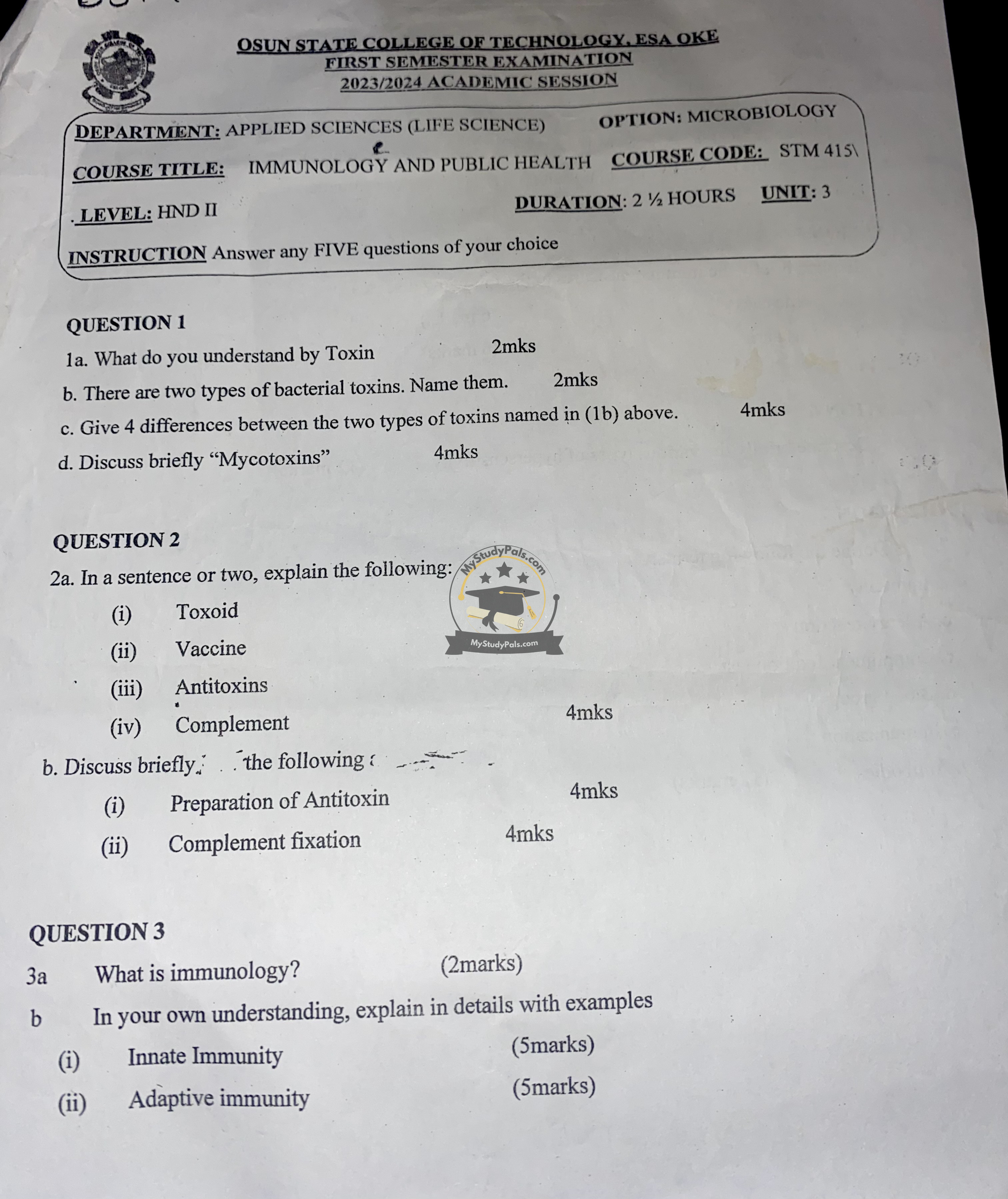ANWSER
Question 1:
a. What do you understand by Toxin?
Answer: A toxin is a poisonous substance produced by living organisms, such as bacteria, plants, or animals, that can cause disease or harm to other organisms.
b. There are two types of bacterial toxins. Name them.
Answer: The two types of bacterial toxins are:
- Exotoxins
- Endotoxins
c. Give 4 differences between the two types of toxins named in (1b) above.
Answer:
| Feature | Exotoxins | Endotoxins |
|---|---|---|
| Origin | Secreted by bacteria | Found in the outer membrane of Gram-negative bacteria |
| Chemical Composition | Proteins | Lipopolysaccharides |
| Heat Stability | Heat labile (destroyed by heat) | Heat stable |
| Mode of Action | Highly specific effects on host cells | Generalized effects such as fever and inflammation |
d. Discuss briefly “Mycotoxins”
Answer: Mycotoxins are toxic secondary metabolites produced by fungi, especially species of Aspergillus, Penicillium, and Fusarium. These toxins contaminate food and feed, leading to serious health effects such as liver damage, cancer, and immune suppression in humans and animals.
Question 2:
a. In a sentence or two, explain the following:
(i) Toxoid
Answer: A toxoid is a modified bacterial toxin that has been rendered non-toxic but still retains its ability to stimulate an immune response, often used in vaccines (e.g., tetanus toxoid).
(ii) Vaccine
Answer: A vaccine is a biological preparation that contains weakened or inactivated pathogens or their components, designed to stimulate the immune system and provide protection against infectious diseases.
(iii) Antitoxins
Answer: Antitoxins are antibodies produced by the immune system or obtained from an external source that neutralize toxins in the body, often used to treat toxin-mediated diseases like diphtheria.
(iv) Complement
Answer: The complement system is a group of proteins in the blood that enhance the immune response by promoting inflammation, opsonization, and the destruction of pathogens.
b. Discuss briefly:
(i) Preparation of Antitoxin
Answer: Antitoxins are prepared by injecting an animal (e.g., horse) with a bacterial toxin in small, increasing doses to stimulate antibody production. The antibodies are then extracted from the animal’s blood, purified, and used as a therapeutic agent.
(ii) Complement fixation
Answer: Complement fixation is a diagnostic test used to detect the presence of antibodies in a patient’s serum by assessing whether the complement system is activated in response to an antigen-antibody reaction.
Question 3:
a. What is immunology?
Answer: Immunology is the branch of biomedical science that studies the immune system, its functions, and its role in protecting the body against infections and diseases.
b. Explain in detail with examples:
(i) Innate Immunity
Answer: Innate immunity is the body’s first line of defense, providing a non-specific response to pathogens. It includes physical barriers (skin, mucous membranes), chemical defenses (enzymes, stomach acid), and cellular responses (macrophages, natural killer cells). Example: Skin preventing bacterial entry.
(ii) Adaptive Immunity
Answer: Adaptive immunity is a specific immune response that develops over time after exposure to pathogens. It includes humoral immunity (B cells producing antibodies) and cell-mediated immunity (T cells attacking infected cells). Example: Immunity acquired after recovering from chickenpox.
Question 4:
a. Public health is an interdisciplinary field. Explain.
Answer: Public health is an interdisciplinary field because it integrates knowledge from various disciplines, such as medicine, epidemiology, sociology, and environmental science, to prevent diseases, promote health, and improve the overall well-being of populations.
b. Define the following:
(i) Health
Answer: Health is a state of complete physical, mental, and social well-being, not merely the absence of disease or infirmity (WHO definition).
(ii) Public Health
Answer: Public health is the science and practice of preventing disease, prolonging life, and promoting health through organized efforts and informed choices of society, organizations, communities, and individuals.
c. Highlight the relevance of public health.
Answer:
- Disease prevention and control
- Health promotion and education
- Improving sanitation and hygiene
- Enhancing vaccination programs
- Ensuring access to healthcare services
Question 5:
Explain briefly the immune measures to the following diseases:
a. Measles
Answer: The primary immune measure for measles is vaccination with the MMR (Measles, Mumps, Rubella) vaccine, which provides long-term immunity. Other measures include post-exposure prophylaxis with immunoglobulin and symptomatic treatment.
b. Malaria
Answer: Immune measures against malaria include the use of anti-malarial drugs (e.g., chloroquine, artemisinin-based therapies), vector control (mosquito nets, insecticides), and vaccination (e.g., RTS,S malaria vaccine).
Question 6:
Describe briefly the various types of hypersensitivity.
Answer: Hypersensitivity reactions are exaggerated immune responses classified into four types:
- Type I (Immediate Hypersensitivity): IgE-mediated allergic reactions, such as asthma and anaphylaxis.
- Type II (Cytotoxic Hypersensitivity): Antibody-mediated destruction of cells, as seen in hemolytic anemia.
- Type III (Immune Complex-Mediated Hypersensitivity): Deposition of immune complexes in tissues, leading to diseases like lupus.
- Type IV (Delayed-Type Hypersensitivity): T-cell-mediated response, such as contact dermatitis and tuberculosis skin test reactions.
Question 7:
Define the following terms:
a. Immunity
Answer: Immunity is the ability of the body to resist infections and diseases through specific and non-specific defense mechanisms.
b. Allergy reaction
Answer: An allergic reaction is an immune system overreaction to a harmless substance (allergen), leading to symptoms like itching, swelling, and anaphylaxis.
c. Complement fixation test
Answer: The complement fixation test is a laboratory diagnostic tool used to detect the presence of specific antibodies in a patient’s serum by measuring the activation of the complement system.
d. Blood groups
Answer: Blood groups are classifications of blood based on the presence or absence of specific antigens on red blood cells, such as the ABO and Rh systems.
e. Immunization
Answer: Immunization is the process of inducing immunity against infectious diseases through vaccination or passive antibody transfer.
f. Antibodies
Answer: Antibodies (immunoglobulins) are Y-shaped proteins produced by B cells that recognize and neutralize pathogens by binding to their antigens.



